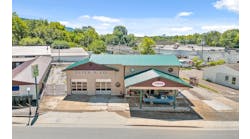Shop: Fix Auto Fifth Avenue Owner: Kekoa Iaea Location: Anchorage, Alaska Staff Size: 19 (4 front office/15 back-end) Shop Size: 17,000 square feet Average Monthly Car Count: 11 (5 in front office/6 technicians) Annual Revenue: $3.7 million Average Repair Order: $1,000-$1,500
Anchorage is Alaska’s largest city, with a population of over 200,000 people. Anchorage also comprises 1,961 square miles.
Yet, Anchorage is a town that feels so small, Miranda Burton, manager for Fix Auto Fifth Avenue, says that every body shop knows of and about each other.
In fact, if a body shop wants to stand out and become Audi certified, for example, that means no other body shops within 50 miles of that Alaska shop can be Audi certified.
So, in a town where competition thrives, how can a body shop grow? In Burton’s mind, she knew she needed a competitive edge, especially during colder months. During those months, her shop was producing about $300,000 in sales—solid, but below expectations.
Burton found the key was in creating partnerships with other businesses in town and making sure her shop built upon its strengths, like its OEM certifications.
The Backstory
Burton took over as manager of the Fifth Avenue location in 2013 (there are six Fix Auto Alaska locations in total), after working in the front office of another shop and then in production management for Fix Auto.
Initially, she experienced plenty of stress about juggling the profit and loss statements for the facility while also leading a team. Over time, she started to grasp how to juggle both sides of the business, in part due to tools like the Fix Auto dashboard, which tracks KPIs like in-process sales, work in progress, and capture ratio, and in part by utilizing her strengths as a manager.
One of Burton’s strengths is setting a goal and ensuring that it’s carried out to completion. In that spirit, the shop manager decided to reach out to local dealerships to form partnerships. Within the surrounding 15 miles of the shop, there are four local dealerships. She wanted to receive any work coming from the dealerships because none of the dealerships had designated body shops.
Initially, the owner of Fix Auto Alaska, Kekoa Iaea, went to the first dealership that had its body shop closing. He purchased the building and added another body shop there while making an agreement with the dealership to send repair work to the MSO’s facility.
Then, Burton went to her local dealerships and spent about an hour talking to their leadership. In the end, she formed agreements in which the service department would pass on their work to her and she would, in return, purchase OEM parts. She partnered with three of the four dealerships.
Throughout the beginning of the partnership, she also tracked how much work was being brought in by the dealership.
Burton discovered it was not a significant sum.
The Problem
Despite forging the aforementioned partnerships, the Alaska body shop was missing out on money, Burton realized. Her dealership partners were sending some work to other body shops in the area based on need and time. She figured the shop needed a way to differentiate itself from competitors.
As a result, Burton invested in certifications. The shop became certified for Nissan, Toyota, Subaru, Volkswagen, Ford and Audi so that it could market such certifications to potential customers. A typical certification cost the shop between $7,000 and $10,000, which includes cost of equipment and training classes.
“It’s not cheap, but it’s worth it,” Burton says.
Once Fix Auto Fifth Avenue became certified, the shop increased its dealership work by about $10,000, to nearly $38,000 per year. Yet, that was not a truly significant jump, Burton felt.
Burton typically met with the dealers a couple times every quarter. She went in again to meet with the service department manager to see what the issue was.
After observing a few interactions with customers needing body work done, she figured out where the roadblock appeared. The service department staff was not informing customers that her body shop facility was indeed certified.
The Solution
Burton eventually met with the dealership liaisons to inform them about Fix Auto Fifth Avenue’s unique selling points, such as its multiple OEM certifications.
Sitting down with her representative in the service department, the body shop manager laid out her case:
Burton informed her partners that the shop’s certifications meant it was qualified to
work on most vehicles and repair them to a standard that wouldn’t affect the manufacturer’s warranty.
Burton pitched how beneficial it was for dealerships to keep sending as much body
work as possible to her shop. Unlike some other body shops in the area, she uses BodyShop Booster, a product which helps her turn around estimates faster and makes the process easier on the customer, who can send in photos of vehicle damage remotely. The dealership would then be able to quickly see the cost of the estimate and if they’d like to proceed with the work.
Burton shared a selling point that her body shop has lot porters who would be able
to pick up a car from the dealership and transport it to the body shop, and vice versa. Furthermore, Fix Auto Fifth Avenue’s lot porters have undergone a background check and driver’s license test.
Burton gave her business partner the OEM pamphlets that detailed precisely which
work the certified body shop could do. She told the service department staff members that they could display these pamphlets to customers to clarify the shop’s array of repair capabilities.
“I knew I needed to become partners with dealerships in my area,” the body shop manager says. “Nowadays, the customer’s first phone call after an accident isn't to the insurance company but it seems to be to the dealer where they first purchased their car.”
The Aftermath
Since sitting down with the dealership to hone in on a plan for sharing work, Burton has increased the amount of sales coming from the dealerships. Today, she is in contact with the dealerships approximately once per day.
Now, the body shop brings in over $200,000 in work from the dealership partnerships, Burton says. She now makes it a priority to send an estimate to the dealership as quickly as possible. For example, she can send an estimate for them to approve via email within one day.
The Takeaway
Partnering with local dealerships was not without its challenges for Burton and Fix Auto Fifth Avenue. The shop sees newer vehicles that require calibration work to be done and complex repair work. And, negotiating dealer rates also proves to be a challenge.
However, Burton says she’s learned that if you ask for an opportunity with business partners, a reasoned, thoroughly explained request will typically be granted.
“Becoming a certified body shop is not cheap, but it’s worth it,” Burton says. “It helps when you’re competing for a spot within that 50 mile range.”



